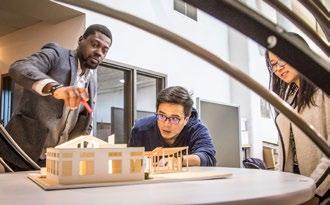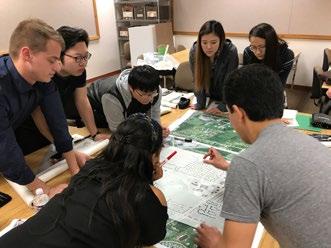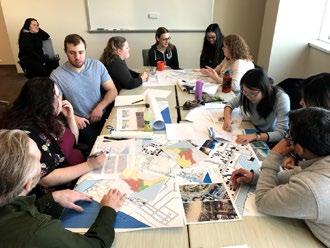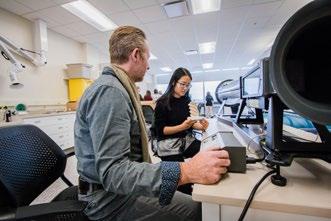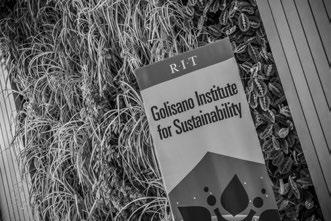
6 minute read
Rochester Institute of Technology Golisano Institute for Sustainability
ROCHESTER INSTITUTE OF TECHNOLOGY 111 Lomb Memorial Drive Rochester, NY 14624 Phone: 585.475.4990 https://www.rit.edu/study/ architecture-march
Dennis A. Andrejko, FAIA, Head
Student Faculty Ratio: 10:1
Tuition & Fees: $50,136 /Year
Number of Students: 50
Application Deadlines: 1/15; Rolling
Type of Campus: Suburban/Urban
PROGRAM
Architecture continues to be in a time of great transition. Globalization, policy making, advanced materials development, and the challenges facing urban environments place great demands on architects to be well versed in concepts outside their immediate field, and able to work effectively with professionals from a variety of disciplines. The Master of Architecture program is designed for students with a broad range of interests and backgrounds who are interested in studying architecture at the graduate level, and whose undergraduate degrees were obtained in fields both inside of and outside of architecture. The program’s curriculum has been shaped by the global emphasis of sustainability, factors that impact urbanism, the integration of design thought with the built environment and community investigation, and the hands-on application of the principles of design and technology of materials, construction and production. This Department of Architecture is housed within the Golisano Institute for Sustainability (GIS) and has a collaborative partnership with RIT’s College of Art and Design (CAD). The GIS Sustainability Institute Hall is a unique and state of the art high performance living, learning laboratory provides a unique setting for testing and evaluating sustainability concepts.
PROGRAM INFORMATION
Our innovative Master of Architecture program is geared toward preparation for 21st century practice in an increasingly inter-disciplinary and inter-professional world. This program is founded upon the principle that “sustainability” is an integral and requisite part of the practice of architecture, adding to, and enhancing the value of design. Program Goals include: • Instilling critical thinking concepts in course material to produce broadthinking architects that are wellgrounded in the principles and practices of sustainability. • Providing a comprehensive set of tools to shape students into adept contributors that can effectively create building and planning projects for problem solving at the intersection of architecture and sustainability. The program emphasizes application and collaboration, and students learn and practice the skills and methods of architecture through the lens of sustainability, graduating with the ability to contribute meaningfully to a fully sustainable built environment.
Students are also exposed to the results of cutting-edge research in such areas as material aging, clean technologies, alternative energy solutions, pollution prevention, and green product assessment, among other topics currently underway in the Golisano Institute for Sustainability.
SUSTAINABILITY
Sustainability and resiliency necessities are changing the way we look at architecture, and the way architecture looks to us, and buildings account for large percentages of the world’s energy expenditures and greenhouse gas emissions. In RIT’s accredited Master of Architecture program, we’re moving sustainability forward to create better architecture. Here, you’ll learn how to design with context and substance in areas such as positive energy, building performance, climate-responsive designs, passive resiliency, and more. The global emphasis on sustainability, and RIT’s commitment to progress in this field forms a fundamental pillar of the Master of Architecture program. Emerging architecture professionals entering the field from RIT’s program will have the opportunity to bring with them a unique perspective on sustainability - with an elevated attention to detail, an increased understanding of high
performance buildings and related systems, and a heightened sensitivity around the needs for vibrant, healthy and resilient buildings and communities.
URBANISM
The challenges facing our cities are profound, in which architecture plays a key role. Synergistic urban environments have implications for social, economic, cultural, and environmental health, and RIT’s Master of Architecture program pays particular attention to urban settings and urban principles. The program focuses on the practices and principles of preservation and adaptive reuse, with the city of Rochester serving as an active learning environment.
INTEGRATION
Integration of learning and practice are key elements to our Master of Architecture program. The program’s design curriculum is well integrated with technical coursework and discussion that extends beyond design concepts. Topics such as construction technologies, material science, and building systems have huge implications in design; as does public policy, sociology, urban economic development and other non-design concepts. An educational goal of the program is to acquire collective intelligence in a team environment to the benefit of the communities in which structures are built.
TECHNOLOGY
Mastering current and evolving tools and understanding technology’s implications on design work are important components of an architect’s education. An architecture degree program residing within one of the country’s most respected technology universities provides a distinct advantage. The ability to study specialized areas of technology, and the opportunity to collaborate with engineers, computer scientists, imaging scientists and experts in advanced materials provides an educational environment for architects unlike most any other.
CURRICULUM
Experiential learning provides students the opportunity to put classroom theory into practice and to look holistically at real-world challenges in sustainable architecture today, and community is at the heart of our curriculum. Experiential learning – grounded in design – provides students the opportunity to put classroom theory into practice and look holistically at real-world challenges in sustainable architecture today, with community at the heart of our curriculum. RIT’s relationship with Rochester, NY, and the region allows for first-hand learning opportunities for design inquiry within the context of a larger, multi-faceted community of people and industry. Students with backgrounds unrelated to architecture are required to complete 105 semester credit hours to successfully complete the program, while students with some undergraduate work in architecture can receive advanced standing for courses already successfully met. Designed as a full-time program, courses are offered on campus, primarily during the day. The core of the coursework is studio-based design, while technical courses and electives are predominantly classroom based, but immersed throughout the studio experience. Electives can be drawn from GIS as well as courses offered by the colleges of Liberal Arts, Engineering, Applied Science and Technology, Art and Design, and Business. In addition to three required sustainability courses, students will take one elective with a direct sustainability focus. All students will prepare a thesis during their final year of study.
CO-OP
Gain applicable skills employers are looking for while you’re still in school. RIT’s expertise in developing and managing cooperative education programs will greatly facilitate a student’s ability to obtain these critical training hours. A number of local architecture and engineering firms hire our students; however the co-op requirement may occur in any location including work abroad. RIT’s Master of Architecture program is proud of its 100% job placement rate among our graduates. With our required co-cop experience you will be well prepared after graduation to take on the next steps for leadership and employment in sustainable architecture, design resiliency, community development, smart growth, and green building materials.
INTERNATIONAL EXPERIENCE
All students are required to engage in a study abroad experience. RIT offers a number of international opportunities to its undergraduate and graduate students through affiliation with other universities and organizations. Students may study in Western Europe, India, China, South Korea, Central and South America. Further opportunities include faculty-led programs throughout Europe, including such locations as Italy, Germany, France, Sweden, and Denmark.
ADDITIONAL PROGRAM INFORMATION
For more detailed program information and application requirements for admission please visit the program website at: www.rit.edu/gis/architecture.
